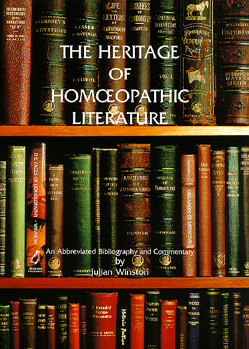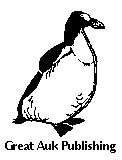 The
Heritage of Homœopathic Literature
The
Heritage of Homœopathic LiteratureThe last full bibliography of homeopathic books in the English Language was Homœopathic Bibliography written by T. L. Bradford in 1892. It missed many of our classic works — all the work of Kent, Boger, Close, Case, Roberts, and much of the English published works of Burnett and Clarke.
An update (1892-1925) was attempted by Cordasco in 1991, but it omitted so many books as to be almost useless.
The Heritage of Homœopathic Literature is an abbreviated bibliography of over 900 of the best and the worst of homeopathic literature from 1810 to 2000. Written by homeopathic historian and editor (Homeopathy Today [USA] Homœopathy NewZ [NZ]) Julian Winston, the book presents the work by category (Materia Medica, Repertory, Domestic Manuals, etc.) and in chronological order. Each entry contains the date, title, author, publisher, and number of pages.
Most of the entries contain expanded detailed descriptions of the contents, and often quotes from contemporary reviews. Many of the entries also have a personal commentary by the author, placing the book into historical context, or commenting upon its relative value.
Here is a extract of the monographs from the "Materia Medica" section (from 1875 to 1880)...
1877: CONDENSED MATERIA MEDICA: Constantine Hering, MD
Boericke and Tafel; 870 pages.
This was an early work which lead to his authoritative Guiding Symptoms. It
was prepared with the help of two of his students, A. Korndoerfer and E. A.
Farrington. It was dedicated to Charles Raue, his pupil and assistant. A 2nd
edition was issued in 1879; a 3rd, edited by E. A. Farrington, was issued in
1884, and a 4th in 1894.
1878: AN ELEMENTARY TEXTBOOK OF MATERIA MEDICA: Allen Corson
Cowperthwaite, MD
Duncan Brothers ; 399 pages.
Cowperthwaite taught at the Hahnemann Medical College in Chicago. This book
begins with a general analysis of each remedy, characteristic symptoms, and
also includes therapeutic and clinical indices. A second edition was published
in 1882. A third edition was published by Gross and Delbridge in 1885, a 4th
in 1887, a 5th in 1890, a 6th (834 pages) in 1891, and an 10th (with 894 pages)
by Boericke and Tafel in 1909.
1878: CLINICAL THERAPEUTICS: Temple Hoyne, MD
Duncan Brothers; 602 pages.
Although titled "Therapeutics" this book is presented as materia medica, using
the symptomatology of the remedy as a framework. It is interspersed with clinical
cases gleaned from the literature, which serve to illustrate the remedies. A
second volume of 643 pages was published in 1880. "During the last four or five
years, I have been repeatedly asked by the students of Hahnemann Medical College
to publish my lectures in book form, in order that they, as well as their preceptors,
might be able to make frequent reference to them."
1878: LECTURES ON MATERIA MEDICA: Carroll Dunham, MD
Francis Hart and Co., New York; 828 pages in two volumes.
Dunham, a student under Boenninghausen, held the position of Chair of Materia
Medica at New York Homeopathic Medical College. Dunham died in 1876 at the age
of 49. The notes from his lectures were compiled by his students and published
two years after his death. Said Samuel A. Jones, "His lectures are not today
in such shape as he would have given them to the world; they are to as though
we had stolen into the classroom unseen and overheard him talking to the boys."
A second edition was published by Boericke and Tafel in 1880.
Kent, in 1899, wrote that he hoped the Dunham College of Chicago would "...teach materia medica as Dunham taught it."
1879: THE GUIDING SYMPTOMS OF THE MATERIA MEDICA: Constantine
Hering, MD
J. M. Stoddart (vol. 1-4), The Estate of C. Hering (vols. 5-10).
1879 marked the release of the first volume, Abies to Amoracea satira. The second
volume, Arnica to Bromium, was released in 1880 shortly before Hering's death.
The subsequent volumes were completed by his students Raue, Knerr, and Mohr.
They were as follows: vol. 3 (Byonia to Chamomilla): 1881; vol. 4 (Chelidonium
to Cubeba): 1884; vol. 5 (Condurango to Helonias): 1887; vol. 6 (Hepar to Lachesis),
7 (Lachnanthes to Natrum muriaticum): 1888; vol. 8 (Natrum phos. to Pulsatilla):
1889; vol. 9 (Ranunculus bulbosa to Stannum): 1890; vol. 10 (Staphisagria to
Zizia): 1891.
Sadly, the book was not completed by Hering, (who died during proof-reading Cainca in Volume 3) but by his pupils, and thus contains innumerable questionable judgments about remedy and symptom grading. Says Kent: "The first two volumes were very good, but after the dear old man was taken from us the rest of the work was not up to standard and is full of foolish things. Though it is the best reference book of the present day, it is far from the perfect work needed."
The information is a grand record of confirmed symptoms seen in over 50 years of practice. It is , with all its faults, an invaluable resource to the homeopathic practitioner and should be one of the first "larger" purchases when one is looking for a very complete materia medica.
1879: THE INCOMPATIBLE REMEDIES: Charles Mohr, MD
Boericke and Tafel; 9 pages.
A paper presented to the Homeopathic Medical Society of Philadelphia. The author
discusses the concept of "incompatible," gives some case examples from practice,
and presents a list of remedy relationships.
This book is, without doubt, the most comprehensive review of the homeopathic literature ever published. If you want to know what homeopathic books or journals have been published in English and if you want to know something about them, this is the book to get. No other person could have written such a comprehensive book other than Julian Winston. And best of all, you can be confident that he has double and tripled checked every fact. Anyone and everyone who is serious about homeopathy should have this book, and once you have it, you will realize the veritable treasure trove of homeopathic literature that exists..”
Dana Ullman, MPH, Author and publisher
“The main reason why we create order is to help us see things clearly. Well, that is exactly what the author has done in this, his latest work.
Just as he ordered the history and people of homeopathy with his masterful The Faces of Homœopathy , he has now done so with the literature. One only has to glance at this book to see order, deeper to see design, and deeper still to see detail and finally, love. The homeopathic literature was and is created out of love, a people's love for healing, a people's love for the truth. This important bibliography will be of assistance to all who encounter homeopathy and Mr. Winston's love hath wrought it.”
Jay Yasgur, RPh, author of Yasgur's Homeopathic Dictionary
“ 'Appetite, paper for' — this symptom definitely isn't limited to people who need a dose of Lac felinum!
Many homoeopaths of old cultivated this symptom— nowadays modern software with extensive original writings seems to replace the bookshelves of our predecessors.
Julian Winston's new book will stimulate the salivation of those, who enjoy delving deep into literature as well as those who only want to pick up a tid-bit from here or there. Doesn't matter if you are a glutton or a picky eater — concerning your appetite for books, of course: everyone's appetite will be satisfied, according to your personal preferences.
Before opening the 243 pages (it's amazing, how much info can be gathered in such a small volume) your eyes will focus on the marvellous cover showing a gallery of books, probably with a little feeling of envy when looking at some of the treasures in the author's possession. Well, I would just want to pull out one volume after the other, take a seat in a comfortable chair and indulge in reading, hour after hour.
This visual impression gets even stronger, when you browse though the chapters. The clarity of the structure, as already seen in his previous book The Faces of Homœopathy , allows you to choose a subject like The Organon, Principles, Materia Medica, Repertory, Veterinary Manuals, Pharmacy, Critical works, Biography— and then a short intro by the author follows, describing, which sort of books were included and why. The listings contain year, title, author, publisher, editions, (a special notation shows if the book is still in print) - and then you'll find sprinkled here and there like sparkling drops of dew some of Julian's comments: sharp or witty, some personal recommendations, some info about the development of a book, etc. I'm glad he put all of them in italics, so they are easy to find!
The monographs of 915 works from the years 1810 to 2000 will give you an overview of the literature published in English (as well as some of the old German writings). Here and there my eyes were caught by special titles (e.g. 1895: Delicate, backward, puny and stunted children by J.C. Burnett. — J. Winston's commentary: "One of my favorite homeopathic titles. No 'political correctness' here. The title 'Children with Developmental Challenges' just doesn't have the same ring!"), and from time to time my pencil drew an arrow: another book to be bought!
What more can I say? This book is a must-have for homoeopaths, but be careful: It will definitely add not only ONE book to your 'literary armamentarium' but increase the size of your book-shelves by more than just 2 inches. Cause I'm sure, you'll also want to buy some of the works mentioned in this book.
What will be J. Winston's next work? As for me, after the The Faces of Homœopathy the Heritage of Homœopathic Literature has its place in the historic part of my bookshelf - as will have the next book of this author.
Gaby Rottler, Germany
 The
Heritage of Homœopathic Literature is available through most homeopathic
book-sellers for $US 35.00.
The
Heritage of Homœopathic Literature is available through most homeopathic
book-sellers for $US 35.00.
For bulk orders, contact the publisher at:
PO Box 51-156, Tawa, Wellington, New Zealand
or e-mail us here.